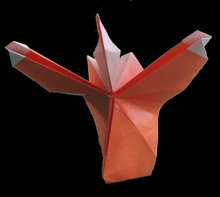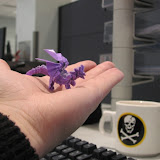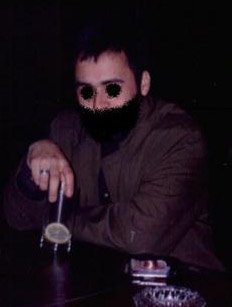 Hi,
Hi,Loyal to that workshop, I enlisted the main objectives I wished to accomplish in an order of priorities:
- it should be a flying condor, with its wings opened in glide.
- have a color change to provide it with a white neck, characteristic of it.
- with its legs withdraw in flying position (I love birds with their legs, they give the model a felling of completitude, even if the figure is not completely closed)
- With its long feathers on the top of the wings, also characteristics of its specie.
- should be an ellegant and have an easy look, not too carrion-like.
the first two conditions were out of the question, so I felt into them. First one influenced strongly on the base choice; if I wish long extended wings, I should use preferently the main diagonal of the square and the other two corners for the head and tail. Soon I got one good answer from the figures I've folded until now, Anibal Voyer's pegasus base:

If I folded AB and AC with valleys not only I'll get a couple of long wings and enough paper for head and tail, but also being slightly inclined folds I'll obtain a 3D curve bending the wing down on flight.
Then there was the head problem and its famous color change, as I had to reduced the top triangle to the center of the model, since Condor's heads are much smaller than their wings, I had to hide paper in wing's frontal edge, which nevertheless gave them a thick axis to enforce their shape and whole forming and posture. Hidding three layers resulted on a small white triangle in the center of the model. But when I folded front and closed that triangle I couldn't find any way to produce the color change to create the white neck without sacrificing the usage of the top corner for the beak or getting a too wide neck to the edges of the wings. After many weeks and models folded, finally I founded a trick and a solution



I passed into the wings and their finger like feathers problems, box pleating fingers didn't help me, because they produced long layered bands along the wings. I was again lost until I saw Román Díaz's Kingfisher, which probed me that best solutions often are the simplest, with feathers suggested by simple marking them, giving me this result:

pretty OK to me. Still, after watching this eagle from Nguyen Hung Cuong, I tried to test overlaying of flaps, which I definitely chose.
And the tail. I tested many different tails and the solution I liked the most was an achordeon or semi box pleated one, which gave the model some ellegance, at the time that simulates rear wing feathers and hide the inside of the model, but I'm not totally decided.
This Condor still needs a lot of work and developing, details like the head comb (which I think I'll get enlarging and trimming the head) but no doubt it has teached me a lot. I'll fold it in a better paper and more finished and post it in the future weeks, I hope you like it and also looking forwrd to know your opinions
And the tail. I tested many different tails and the solution I liked the most was an achordeon or semi box pleated one, which gave the model some ellegance, at the time that simulates rear wing feathers and hide the inside of the model, but I'm not totally decided.
This Condor still needs a lot of work and developing, details like the head comb (which I think I'll get enlarging and trimming the head) but no doubt it has teached me a lot. I'll fold it in a better paper and more finished and post it in the future weeks, I hope you like it and also looking forwrd to know your opinions
Many regards.





2 comments:
Great model! I still wish you would come along and correct the errors in the english, I know you can.
Hi Cupcake
thanks a lot for your lecture and comments, I already corrected the english a little; it was pretty late when I wrote the entry.
Paper III is coming!
Post a Comment